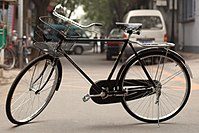
Photo from wikipedia
BACKGROUND A variety of intensity, load, and performance measures (eg, "power profile") have been used to characterize the demands of professional cycling races with differing stage types. An increased understanding of… Click to show full abstract
BACKGROUND A variety of intensity, load, and performance measures (eg, "power profile") have been used to characterize the demands of professional cycling races with differing stage types. An increased understanding of the characteristics of these races could provide valuable insight for practitioners toward the design of training strategies to optimally prepare for these demands. However, current reviews within this area are outdated and do not include a recent influx of new articles describing the demands of professional cycling races. PURPOSE To provide an updated overview of the intensity and load demands and power profile of professional cycling races. Typically adopted measures are introduced and their results summarized. CONCLUSION There is a clear trend in the research that stage type significantly influences the intensity, load, and power profile of races with more elevation gain typically resulting in a higher intensity and load and longer-duration power outputs (ie, >10 min). Flat and semimountainous stages are characterized by higher maximal mean power outputs over shorter durations (ie, <2 min). Furthermore, single-day races tend to have a higher (daily) intensity and load compared with stages within multiday races. Nevertheless, while the presented mean (grouped) data provide some indications on the demands of these races and differences between varying competition elements, a limited amount of research is available describing the "race-winning efforts" in these races, and this is proposed as an important area for future research. Finally, practitioners should consider the limitations of each metric individually, and a multivariable approach to analyzing races is advocated.
Journal Title: International journal of sports physiology and performance
Year Published: 2020
Link to full text (if available)
Share on Social Media: Sign Up to like & get
recommendations!